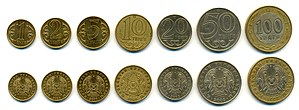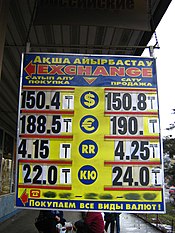тиын
→
тиын — существительное, именительный п., муж. p., ед. ч.
↳
тиын — существительное, винительный п., муж. p., ед. ч.
Часть речи: существительное
| Единственное число | Множественное число | |
|---|---|---|
| Им. |
тиын |
тиыны |
| Рд. |
тиына |
тиынов |
| Дт. |
тиыну |
тиынам |
| Вн. |
тиын |
тиыны |
| Тв. |
тиыном |
тиынами |
| Пр. |
тиыне |
тиынах |
Если вы нашли ошибку, пожалуйста, выделите фрагмент текста и нажмите Ctrl+Enter.
Тиы́н — казахстанская разменная денежная единица, 1/100 казахстанского тенге. Выведена из наличного обращения и условно используется лишь в безналичном. Все суммы в тиынах согласно законодательству требуется округлять до целого тенге при наличном расчёте.
В Советское время
В советскую эпоху словом «тиын» называлась копейка, а словом «сом» — рубль[источник не указан 82 дня].
История
Тиын, как 1/100 часть национальной валюты Казахстана — тенге, был введён в обращение на территории Республики Казахстан с 08.00 часов местного времени 15 ноября 1993 года, а с 08.00 часов местного времени 18 ноября 1993 года тенге, состоящее из 100 тиынов, стало единственным законным платежным средством в Казахстане.[1] Бумажные тиыны появились в 1993 году и были выпущены номиналом 1, 2, 5, 10, 20, 50 тиынов. Монеты появились в 1994 году и были изготовлены из сплава Л-80 жёлтого цвета номиналом 2, 5, 10, 20, 50 тиынов.
7 февраля 2001 года в связи с тем, что в денежном обращении при наличной форме платежей было фактически прекращено использование денежных знаков — тиынов, Указом Президента Казахстана было постановлено изъять из денежного обращения наличные тиыны, при этом учёт и отражение тиынов во всех платёжных документах и порядок осуществления безналичных платежей с использованием тиынов остался неизменным.[2] В соответствии с данным указом Национальным банком Казахстана были разработаны, а 3 марта 2001 года утверждены Правила изъятия из денежного обращения наличных денежных знаков — тиын. Правилами не был установлен предельный срок изъятия из денежного обращения наличных тиынов, согласно им он должен осуществляться до их полного выведения из денежного обращения.[3]
Банкноты
| Изображение | Номинал | Основной цвет |
Дата печати |
Вывод из обращения |
|
|---|---|---|---|---|---|
| Аверс | Реверс | ||||
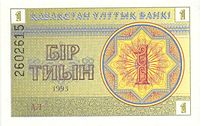 |
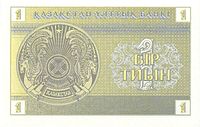 |
1 тиын | Зелёный | 1993 | 2001 |
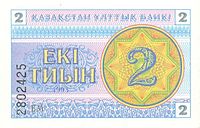 |
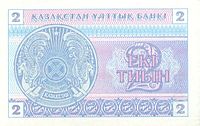 |
2 тиына | Синий | ||
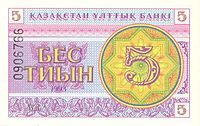 |
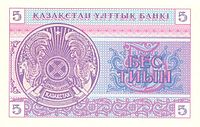 |
5 тиынов | Фиолетовый | ||
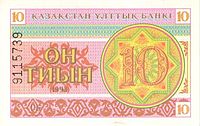 |
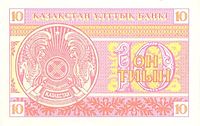 |
10 тиынов | Розовый | ||
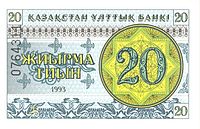 |
 |
20 тиынов | Бирюзовый | ||
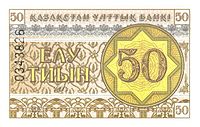 |
 |
50 тиынов | Коричневый |
Монеты
| Монеты | ||||
|---|---|---|---|---|
 |
 |
 |
 |
 |
| 2 тиына | 5 тиынов | 10 тиынов | 20 тиынов | 50 тиынов |
См. также
- Тин
- Тийин
- Тыйын
Примечания
- ↑ Указ Президента Республики Казахстан от 12 ноября 1993 года № 1399 «О введении национальной валюты Республики Казахстан».
- ↑ Указ Президента Республики Казахстан от 7 февраля 2001 года № 549 «О некоторых вопросах функционирования национальной валюты Республики Казахстан».
- ↑ Правила изъятия из денежного обращения наличных денежных знаков — тиын (утверждены Постановлением Правления Национального Банка Республики Казахстан от 3 марта 2001 года № 57 «Об утверждении Правил изъятия из денежного обращения наличных денежных знаков — тиын»).
| |
|
|---|---|
| От слова «сто» (в т. ч. лат. centum) | Евроцент · Киндарка · Сантим · Сен · Сенити · Сентаво (Восточный Тимор · Эквадор) · Сенте · Сенти · Сентесимо (Панама) · Сентимо · Стотин · Стотинка · Цент (Гонконг) · Чентезимо |
| От латинских корней | Грош · Дайм · Дени · Десим · Динар · Кобо · Куруш (керш, кирш) · Лума · Миллим, милльем (мильем) · Милль (Гонконг) · Пул · Су · Филс · Эре · Эйре |
| От др.-греч. δραχμή («драхма») | Дирам · Дирхам |
| От романских и германских корней | Бан (бань) · Геллер · Пенни (Британия · Ирландия · Финляндия) · Пеннинг · Пиастр · Пфенниг (Рейхспфенниг · Рентный) · Фартинг · Фенинг · Филлер (филер) |
| От славянских корней | Гяпик · Копейка · Липа |
| От семитских корней | Агора · Халал · Хумс |
| От персидских корней | Байза · Денга (деньга) · Лари (ларин) · Пайс (пайса) · Пойша · Тенге |
| От тюркских корней | Алтын · Пара · Тийин · Тиын · Тыйын |
| От китайских корней | Цянь · Сен (сэн) · Чон Джиао · Как · Хао · Хо · Хоу · Цзяо Рин · Фын (фынь) |
| От бантоидных корней | Нгве · Тамбала · Тхебе |
| Прочие | Аво · Ат · Бутут · Ираймбиланья · Мунгу · Песева · Пья · Сатанг · Тетри · Тойя · Чертум (четрум) |
| См. также | Деньги Мэнди · Сен (денежная единица) · Лепта |
|
|
|---|---|

₸5,000 note |
|
| ISO 4217 | |
| Code | KZT (numeric: 398) |
| Subunit | 0.01 |
| Unit | |
| Plural | The language(s) of this currency do(es) not have a morphological plural distinction. |
| Symbol | ₸ |
| Denominations | |
| Subunit | |
| 1⁄100 | tiyn (тиын) |
| Banknotes | |
| Freq. used | ₸200, ₸500, ₸1,000, ₸2,000, ₸5,000, ₸10,000, ₸20,000 |
| Coins | |
| Freq. used | ₸5, ₸10, ₸20, ₸50, ₸100, ₸200 |
| Rarely used | ₸1, ₸2 |
| Demographics | |
| User(s) | |
| Issuance | |
| Central bank | National Bank of Kazakhstan |
| Website | www.nationalbank.kz |
| Printer | Banknote Factory of the National Bank of Kazakhstan |
| Valuation | |
| Inflation | 4.9%[1] |
| Source | Basic Macroeconomic Indicators on the homepage |
The tenge ([2] or ;[3] Kazakh: теңге, teñge, Kazakh pronunciation: [ˌtʲeŋˈɡʲe]; sign: ₸ ; code: KZT) is the currency of Kazakhstan. It is divided into 100 tiyn (Kazakh: тиын, tıyın also transliterated as tiyin).
History[edit]
After the breakup of the Soviet Union in December 1991, most of the formerly Soviet republics attempted to maintain a common currency. Some politicians hoped to at least maintain «special relations» among former Soviet republics (the «near abroad»). Other reasons were the economic considerations for maintaining the rouble zone. The wish to preserve strong trade relations between former Soviet republics was considered the most important goal.[4]
The break-up of the Soviet Union was not accompanied by any formal changes in monetary arrangements. The Central Bank of Russia was authorized[by whom?] to take over the State Bank of the USSR (Gosbank) on 1 January 1992. It continued to ship Soviet notes and coins to the central banks of the eleven newly independent countries, which had formerly been the main branches of Gosbank in the republics.
The political situation, however, was not favourable for maintaining a common currency.[4] Maintaining a common currency requires a strong political consensus in respect to monetary and fiscal targets, a common institution in charge of implementing these targets, and some minimum of common legislation (concerning the banking and foreign-exchange regulations).[citation needed] These conditions were far from being met amidst the turbulent economic and political situation.
During the first half of 1992, a monetary union with 15 independent states all using the rouble existed. Since it was clear that the situation would not last, each of them was using its position as «free-riders» to issue huge amounts of money in the form of credit.[5] As a result, some countries were issuing coupons in order to «protect» their markets from buyers from other states. The Russian central bank responded in July 1992 by setting up restrictions to the flow of credit between Russia and other states. The final collapse of the rouble zone began when Russia pulled out with the exchange of banknotes by the Central Bank of Russia on Russian territory at the end of July 1993.
As a result, Kazakhstan and other countries still in the rouble zone were «pushed out».[5] On November 12, 1993, the President of Kazakhstan issued a decree «On introducing national currency of Republic of Kazakhstan». The tenge was introduced on 15 November 1993 to replace Soviet currency at a rate of T 1 = Rbls 500. In 1991 a «special group» of designers was set up: Mendybay Alin, Timur Suleymenov, Asimsaly Duzelkhanov and Khayrulla Gabzhalilov. Thus November 15 is celebrated as the «Day of National Currency of Republic of Kazakhstan». In 1995 a tenge-printing factory opened in Kazakhstan. The first consignment of tenge banknotes were printed in the United Kingdom and the first coins were struck in Germany. In February 2019, Kazakh President Nursultan Nazarbayev signed a bill into law that will remove all Russian captions from future tenge banknotes and coins.[6]
Etymology[edit]
The word tenge in Kazakh and in most other Turkic languages means a set of scales (cf the old Uzbek tenga or the Tajik borrowed term tanga). The origin of the word is the Mongolic word teng (ᠲᠡᠩ) which means «being equal, balance». The name of this currency is thus similar to the pound, lira, peso, taka, and shekel. The name of the currency is also related to the Russian word for money Russian: деньги/ den’gi, which the Old Russian language borrowed from Turkic sources.[7]
Symbol[edit]
The symbol for the Kazakhstani tenge.
Originally a simple letter «Т» was used to denote amounts in tenge, this is still recommended when the tenge symbol is not available.[8] In autumn 2006 the National Bank of Kazakhstan organised a competition for a unique symbol for the currency and received over 30,000 applications.
On March 20, 2007, two days before the Nauryz holiday, the National Bank of Kazakhstan approved a graphical symbol for the tenge: ₸.
On March 29, 2007, the Bank announced two designers from Almaty, Vadim Davydenko and Sanzhar Amirkhanov, as winners for the design of the symbol of the Kazakhstani tenge. They shared a prize of ₸1,000,000 and the title of «parents» of the tenge symbol.[9]
The character was included in Unicode 5.2.0 (August 2009) at code point U+20B8.[10]
Coins[edit]
While older coins were struck in Germany, current coins are struck domestically, by the Kazakhstan Mint in Oskemen.
First series (1993)[edit]
In 1993, the first series of coins were introduced in denominations of 2, 5, 10, 20, and 50 tiyin featuring the national arms and were struck in bronze. The coins of T 1, T 3, T 5, T 10, and T 20 were struck in cupro-nickel and depicted stylized and mythical animals. The coins of this period circulated alongside tiyin and low denomination tenge notes of equal value. Tiyin coins were withdrawn as of February 7, 2001 and lost their effect as legal currency as of December 31, 2012.[11][12]
| Image | Denomination | Material | Diameter | Mass | Thickness | Edge | Date of | ||
|---|---|---|---|---|---|---|---|---|---|
| issue | minting | withdrawal | |||||||

|
2 tiyin | Brass | 17.27 mm | 2.26 g | 1.3 mm | Smooth | 1 March 1994 | 1993 | 31 December 2012 |

|
5 tiyin | ||||||||

|
10 tiyin | 19.56 mm | 3.48 g | 1.6 mm | |||||

|
20 tiyin | 21.87 mm | 4.71 g | 1.7 mm | |||||

|
50 tiyin | 25 mm | 7.43 g | 2 mm | |||||

|
T 1 | Alloy of «nickel silver» | 17.27 mm | 2.26 g | 1.3 mm | Smooth | 25 October 1995 | 1 October 2001 | |

|
T 3 | 19.56 mm | 3.48 g | 1.6 mm | |||||

|
T 5 | 21.87 mm | 4.71 g | 1.7 mm | |||||

|
T 10 | 25 mm | 7.43 g | 2 mm | |||||

|
T 20 | 31 mm | 11.37 g | Grooved |
Second series (1998)[edit]
₸1, ₸2, ₸5, ₸10, ₸20, ₸50 and ₸100 coins of the second series.
In 1998, a new series of coins was introduced. After the withdrawal of tiyin denominated coins T 1 became the smallest denomination. T 100 were later introduced in 2002 replacing the equivalent notes. A T 2 coin was introduced in 2005. In 2013 the alloy of lower denomination coins was altered.
| Second series coins of the Kazakh tenge (1997–2018)[13] | |||||||||||
|---|---|---|---|---|---|---|---|---|---|---|---|
| Image | Value | Technical parameters | Description | Date of | |||||||
| Diameter | Mass | Thickness | Composition | Edge | Obverse | Reverse | minting | issue | withdrawal | lapse | |

|
₸1 | 15 mm | 1.63 g | 1.3 mm | Alloy of «nickel silver», yellow color (since 2013 — carbon steel, galvanic coating yellow metal) |
Plain | Value | Year, Emblem of Kazakhstan | 1997~2018 | 11 November 1998 | Current |

|
₸2 | 16 mm | 1.84 g | 1.3 mm | 2005,2006 | 23 February 2005 | |||||

|
₸5 | 17.27 mm | 2.18 g | 1.3 mm | 1997~2018 | 11 November 1998 | |||||

|
₸10 | 19.56 mm | 2.81 g | 1.3 mm | |||||||

|
₸20 | 18.27 mm | 2.9 g | 1.6 mm | Alloy of «nickel silver», white color (since 2013 — carbon steel and galvanic nickel) | Grooved | Value | Year, Emblem of Kazakhstan | 1997~2018 | 11 November 1998 | Current |

|
₸50 | 23 mm | 4.7 g | 1.6 mm | |||||||

|
₸100 | 24.5 mm | 6.65 g | 1.95 mm | Inner disk: alloy of «nickel silver», white color Outer disk: alloy of «nibrass», yellow color. |
Grooved with the note — «СТО ТЕНГЕ — ЖYЗ ТЕҢГЕ» (one hundred tenge) | 2002~2007 | 1 July 2002 | |||
| These images are to scale at 2.5 pixels per millimetre. For table standards, see the coin specification table. |
Third series (2019)[edit]
In 2019, a new series of coins was introduced into circulation, with the same coin specifications and metallic compositions as the second series. But with the inscriptions of the coins now rendered in Latin-based Kazakh instead of Kazakh-based Cyrillic.
The coins were issued as part of the efforts of the presidential decree issued by former President Nursultan Nazarbayev of its transition of switching from a Cyrillic-based alphabet to a Latin-based alphabet and emphasizing Kazakh culture and distance the country from Russian influence. The designs of the coins were approved by Interim President Qasym-Zhomart Toqaev on March 20, 2019. Previously issued coins bearing the Kazakh Cyrillic script will remain legal tender alongside the new Kazakh Latin inscribed coins.
In 2019, the National Bank of Kazakhstan announced the issuance of new ₸200 coins, which were issued into circulation in 2020. This new denomination features inscriptions in Latin-based Kazakh, and like the ₸100 coin, is bi-metallic.[14]
| Third series coins of the Kazakh tenge (2019–present)[15] | |||||||||||
|---|---|---|---|---|---|---|---|---|---|---|---|
| Image | Value | Technical parameters | Description | Date of | |||||||
| Diameter | Mass | Thickness | Composition | Edge | Obverse | Reverse | minting | issue | withdrawal | lapse | |

|
₸1 | 15 mm | 1.63 g | 1.3 mm | Carbon steel, galvanic coating yellow metal | Plain | Value | Year, Emblem of Kazakhstan | 2019~present | 26 April 2019 | Current |

|
₸2 | 16 mm | 1.84 g | 1.3 mm | |||||||

|
₸5 | 17.27 mm | 2.18 g | 1.3 mm | |||||||

|
₸10 | 19.56 mm | 2.81 g | 1.3 mm | |||||||

|
₸20 | 18.27 mm | 2.9 g | 1.6 mm | Carbon steel and galvanic nickel | Grooved | Value | Year, Emblem of Kazakhstan | 2019~present | 26 April 2019 | Current |

|
₸50 | 23 mm | 4.7 g | 1.6 mm | |||||||

|
₸100 | 24.5 mm | 6.65 g | 1.95 mm | Inner disk: alloy of «nickel silver», white color Outer disk: alloy of «nibrass», yellow color. |
Grooved with the note — «JÚZ TEŃGE» (one hundred tenge) | |||||
 
|
₸200 | 26 mm | 7.5 g | 1.9 mm | Aluminium-brass center in copper-nickel ring | Sixteen indentations (‘Spanish flower’) with alterned plain and reeded sections | 2020~present | 28 January 2020 | |||
| These images are to scale at 2.5 pixels per millimetre. For table standards, see the coin specification table. |
Commemorative coins[edit]
Commemorative coins are issued in denominations of ₸20, ₸50, ₸100, ₸500, ₸1,000, ₸2,500, ₸5,000 and ₸10,000. Silver and gold bullion coins exist in denominations of ₸1, ₸2, ₸5, ₸10, ₸20, ₸50 and ₸100. Many of the ₸20 and ₸50 commemoratives are also struck in cupro-nickel and occasionally make it out into general circulation as a side coinage with face value.
New symbol of tenge (₸) used on info-board of a currency exchange office in Almaty
Banknotes[edit]
1993 series[edit]
On 15 November 1993, the National Bank of Kazakhstan issued notes in denominations of 1, 2, 5, 10, 20, and 50 tiyn, T 1, T 3, T 5, T 10, T 20, and T 50; T 100 notes followed shortly thereafter. These were followed in 1994 by T 200, T 500, and T 1,000 notes. T 2,000 notes were introduced in 1996, with T 5,000 in 1999 and T 10,000 on 28 July 2003.[16] Notes currently in circulation are:
- ₸200 — portrait of Al-Farabi
- ₸500 — portrait of Al-Farabi, fragment of Khodzha Akhmet Yassaui mausoleum
- ₸1,000 — portrait of Al-Farabi
- ₸2,000 — portrait of Al-Farabi
- ₸5,000 — portrait of Al-Farabi
- ₸10,000 — portrait of Al-Farabi, image of snow leopard.
The text on the reverse side of the 200 tenge banknote is written in Kazakh, although text on the reverse sides of the other banknotes is written in Russian.
| 1993 Series | ||||||||
|---|---|---|---|---|---|---|---|---|
| Image | Value | Main Colour | Description | Date | ||||
| Obverse | Reverse | Obverse | Reverse | Obverse | Reverse | issue | annul | |

|

|
1 tiyn | green | green | value in numeral and Kazakh, unique geometric design background | value in numeral and Kazakh, Kazakhstan coat of arms, unique geometric design background | 1993 | 2001 |

|

|
2 tiyn | light blue | light blue | ||||

|

|
5 tiyn | pink | pink | ||||

|

|
10 tiyn | red | red | ||||

|

|
20 tiyn | blue, grey | blue | ||||

|

|
50 tiyn | brown, yellow | brown | ||||

|

|
T 1 | blue | light blue | Portrait of Al-Farabi | Geometrical constructions and formulations of Al-Farabi | 2012–2018 | |

|

|
T 3 | green | bluish green | Portrait of Suinbai Aronuly | Alatau landscape | ||

|

|
T 5 | brown | yellow, orange | Portrait of Kurmangazy | Kurmangazy mausoleum | ||
| T 10 | green | light green | Portrait of Chokan Ualihanov | Ok Zhetpes mountain | ||||
| T 20 | brown | light brown | Portrait of Abay Kunanbaev | Illustration of golden eagle with the man, drawn from works of Abay Kunanbaev | ||||
| T 50 | reddish | light red | Portrait of Abulhair Khan | Rock paintings of Mangistau | ||||
| T 100 | violet | pink | Portrait of Ablay Khan | Hodja Ahmed Yassavi mausoleum | ||||
| T 200 | brown, red | yellow, blue | Portrait of Al-Farabi | Hodja Ahmed Yassavi mausoleum | 1994 | |||
| T 500 | dark blue, blue | blue, violet | Portrait of Al-Farabi | Hodja Ahmed Yassavi mausoleum | ||||
| T 1,000 | green, red | green, blue, red | Portrait of Al-Farabi | Hodja Ahmed Yassavi mausoleum | ||||
| T 2,000 | green, blue | green, brown | Portrait of Al-Farabi | Hodja Ahmed Yassavi mausoleum | 1996 | |||

|

|
T 5,000 | brown, violet | brown | Portrait of Al-Farabi | Hodja Ahmed Yassavi mausoleum | 1998 | |

|

|
T 10,000 | blue | blue, brown | Portrait of Al-Farabi | Snow leopard against a background of mountains | 2003 |
2006 series[edit]
Some ₸2,000 notes spelled the word банкі (bank) incorrectly as банқі.
The National Bank of Kazakhstan issued a new series of tenge banknotes in 2006. This was not a currency reform as they replaced existing notes at face value.
The 2006 series is far more exotic than its predecessors. The obverse is vertical and the denomination is written in Kazakh. All denominations depict the Astana/Nur-Sultan Bayterek monument, the flag of Kazakhstan, the Coat of arms, the handprint with a signature of president Nursultan Nazarbayev and fragments of the national anthem. The main differences across each denomination are only the colours, denominations and underprint patterns.
On the contrast, the reverse side of the notes are more different. The denomination is written in Russian, and each denomination shows a unique building and geography of Kazakhstan in the outline of its borders.
The first printing of the ₸2,000 and ₸5,000 notes issued in 2006 had misspellings of the word for «bank» (the correct spelling «банкі» bankı was misspelled «*банқі» banqı). The misspelling was a politically sensitive issue due to the cultural and political importance of the Kazakh language.[17]
On 3 October 2016, the ₸2,000, ₸5,000 and ₸10,000 banknotes of the 2006 series lost their legal tender status and are no longer valid. From 4 October 2016 to 3 October 2017, these notes can be exchanged without commission at any second tier bank and branches of the National Bank of Kazakhstan.[18]
| 2006 Series | ||||||
|---|---|---|---|---|---|---|
| Image | Value | Main Colour | Description | Date of issue | ||
| Obverse | Reverse | Obverse | Reverse | |||

|

|
₸200 | orange | Nur-Sultan Bayterek monument, Kazakhstan flag, Kazakhstan coat of arms, handprint with a signature of Kazakh President Nursultan Nazarbayev, fragments of the national anthem, value in numerals and Kazakh words, issuing bank in Kazakh, inscription in Kazakh stating that counterfeiting banknotes is against the law | Transport and Communication Ministry and a winged snow leopard on the bridge over River Ishim, outline map of Kazakhstan with Ministry of Defense and the steppes in the background, value in Russian, name of issuing in Kazakh, logo of issuing bank, inscription in Russian stating that counterfeiting banknotes is against the law | 2006–2016[18] |

|

|
₸500 | blue | Ministry of Finance and Akimat (City Hall) of Astana/Nur-Sultan, outline map of Kazakhstan with gulls over the sea in background, value in Russian, name of issuing in Kazakh, logo of issuing bank, inscription in Russian stating that counterfeiting banknotes is against the law | ||

|

|
₸1,000 | brown | President Culture Center, outline map of Kazakhstan with mountains in background, value in Russian, name of issuing in Kazakh, logo of issuing bank, inscription in Russian stating that counterfeiting banknotes is against the law | ||

|

|
₸2,000 | green | Abai Opera House, outline map of Kazakhstan with mountain lake in background, value in Russian, name of issuing in Kazakh, logo of issuing bank, inscription in Russian stating that counterfeiting banknotes is against the law | ||

|

|
₸5,000 | red | Independence Monument and the Kazakhstan Hotel, outline map of Kazakhstan with mountains in background, value in Russian, name of issuing in Kazakh, logo of issuing bank, inscription in Russian stating that counterfeiting banknotes is against the law | ||

|

|
₸10,000 | purple | Residence Akorda (presidential palace), outline map of Kazakhstan with canyons in the background, value in Russian, name of issuing in Kazakh, logo of issuing bank, inscription in Russian stating that counterfeiting banknotes is against the law |
2011–2017 series[edit]
The National Bank of Kazakhstan issued a new series of tenge banknotes dated 2011, 2012, 2013 and 2014 in denominations of ₸1,000, ₸2,000, ₸5,000, and ₸10,000.[19][20][21][22] The designs for this series feature the «Kazakh Eli» monument on the front of the notes. On 1 December 2015, a new ₸20,000 banknote was introduced. It contains the issue date of 2013, and is a commemorative note to celebrate the 20th anniversary of the introduction of its national currency, but was not issued until 2015.[23] In 2017, the National Bank of Kazakhstan issued a ₸500 banknote as part of this series, but has caused controversy over an image of a gull on the reverse side of the note and the image of the Moscow business center in Kazakhstan’s capital of Nur-Sultan.[24]
| 2011–2017 Series | ||||||
|---|---|---|---|---|---|---|
| Image | Value | Main Color | Description | Date of issue | ||
| Obverse | Reverse | Obverse | Reverse | |||
| [2] | [3] | ₸500 | Blue | Flag, skyscrapers, «Kazakh Eli» monument in Astana/Nur-Sultan (representing the «Independence of Kazakhstan» and the «Continuation of Generations»), Emblem of Kazakhstan and Flag of Kazakhstan | Outline of Kazakhstan, seagulls | 2017 |
| [4] | [5] | ₸1,000 | Yellow, brown, orange and blue | «Kazakh Eli» monument in Astana/Nur-Sultan (representing the «independence of Kazakhstan» and the «Continuation of Generations»), pigeons, Emblem of Kazakhstan and Flag of Kazakhstan | Outline of Kazakhstan, mountains and landscape of the Ustyurt Plateau | 2014 |
| [6] | [7] | ₸2,000 | Green | «Kazakh Eli» monument in Astana/Nur-Sultan (representing the «independence of Kazakhstan» and the «Continuation of Generations»), Khan Shatyr tent, pigeons, Emblem of Kazakhstan and Flag of Kazakhstan | Outline of Kazakhstan, Ertis/Irtysh river | 2012 |
| [8] | [9] | ₸5,000 | Red, blue, yellow, and green | «Kazakh Eli» monument in Astana/Nur-Sultan (representing the «independence of Kazakhstan» and the «Continuation of Generations»), Palace of Independence, pigeons, Emblem of Kazakhstan and Flag of Kazakhstan | Outline of Kazakhstan, Monument of Independence, Hotel «Kazakhstan» (Almaty/Alma Ata), Zailijsky Alatau ridge of Tjan-Shan mountain range | 2011 |
| [10] | [11] | ₸10,000 | Violet and blue | «Kazakh Eli» monument in Astana/Nur-Sultan (representing the «independence of Kazakhstan» and the «Continuation of Generations»), Palace of Independence, pigeons, Emblem of Kazakhstan and Flag of Kazakhstan | Outline of Kazakhstan, Residence Ak Orda (Palace of the President), Astana/Nur-Sultan | 2012 |
| [12] | [13] | ₸20,000 | Blue-gray and violet | «Kazakh Eli» monument in Astana/Nur-Sultan (representing the «independence of Kazakhstan» and the «Continuation of Generations»), pigeons, Emblem of Kazakhstan, Flag of Kazakhstan and the Mangilik El triumphal arch | Outline of Kazakhstan, Residence Ak Orda (Palace of the President) and Government buildings in Astana/Nur-Sultan, arranged in order by the principle of separation of powers, as written in the Constitution of the Republic of Kazakhstan | 2015[25] |
New series with security features 2008[edit]
Since 2008, a number of commemorative designs have been issued, including notes celebrating the 2011 Asian Winter Games hosted in Nur-Sultan. Commemoratives can typically be found in these denominations: ₸1,000, ₸2,000, ₸5,000, and ₸10,000.
Digital tenge[edit]
The National Bank of Kazakhstan publicly released plans to develop a national digital currency.[26]
Commemorative banknotes[edit]
- T 5,000 (2001)
-
5,000 tenge banknote issued in 2001 with overprint to commemorate the tenth anniversary of independence from the Soviet Union (front).
-
5,000 tenge banknote issued in 2001 with overprint to commemorate the tenth anniversary of independence from the Soviet Union (back).
- ₸5,000 (2008)
-
5,000 tenge banknote issued in 2008 to commemorate 15 years of the Kazakhstani tenge (front).
-
5,000 tenge banknote issued in 2008 to commemorate 15 years of the Kazakhstani tenge (back).
- ₸1,000 (2010)
-
1,000 tenge banknote issued in 2010 to commemorate the Chairmanship of Kazakhstan in the OSCE (front).
-
1,000 tenge banknote issued in 2010 to commemorate the Chairmanship of Kazakhstan in the OSCE (back).
- ₸1,000 (2011)
- ₸2,000 (2011)
- ₸10,000 (2011)
-
10,000 tenge banknote issued in 2011 to commemorate the 20th anniversary of independence from the Soviet Union (front).
-
10,000 tenge banknote issued in 2011 to commemorate the 20th anniversary of independence from the Soviet Union (back).
- ₸1,000 (2013)
1,000 tenge banknote issued in 2013 to commemorate the «Kul Tigin» – the monument of the Turkic runic writing.
- ₸10,000 (2016)
The National Bank of Kazakhstan issued a 10,000 tenge commemorative banknote to commemorate the 25th anniversary of independence from the Soviet Union. The commemorative note contains an image of Kazakh President Nursultan Nazarbayev,[27] and was launched into circulation on the Day of the First President, December 1, 2016.
- ₸20,000 (2021)
The National Bank of Kazakhstan issued a 20,000 tenge commemorative banknote to commemorate the 30th anniversary of independence from the Soviet Union. The commemorative note features images of the first president of Kazakhstan, «Elbasy» Nursultan Nazarbayev, the Akorda Presidential Palace, a view of the capital city of Nur-Sultan and the official logo for the celebrations. The commemorative note is also the first to feature inscriptions in Kazakh-based Latin instead of Kazakh-based Cyrillic. The commemorative note was issued on December 16, 2021.[28]
Exchange rates and inflation[edit]
On September 2, 2013, the National Bank of Kazakhstan moved the tenge from a managed float and pegged it to the US dollar and the rouble.[29]
On February 11, 2014, the Kazakh National Bank chose to devalue the tenge by 19% against the U.S. dollar in response to a weakening of the Russian ruble.[30]
On August 20, 2015, The Kazakhstan National Bank has done away with the currency band with respect to conversion rate of tenge. Now, the tenge is a free-floating currency and its exchange rate against the major currencies are determined by demand and supply in the market. Due to this change, the tenge lost 30% of its value in a single day.[31]
| Current KZT exchange rates | |
|---|---|
| From Google Finance: | AUD CAD CHF CNY EUR GBP HKD JPY USD RUB EUR JPY |
| From Yahoo! Finance: | AUD CAD CHF CNY EUR GBP HKD JPY USD RUB EUR JPY |
| From XE.com: | AUD CAD CHF CNY EUR GBP HKD JPY USD RUB EUR JPY |
| From OANDA: | AUD CAD CHF CNY EUR GBP HKD JPY USD RUB EUR JPY |
| USD | EUR | RUB | |
|---|---|---|---|
| 1999 | 119.52 | 130.00 | 4.82 |
| 2000 | 142.13 | 134.40 | 5.05 |
| 2001 | 146.74 | 132.40 | 5.04 |
| 2002 | 153.28 | 144.68 | 4.89 |
| 2003 | n/a | 168.79 | 4.87 |
| 2004 | 136.04 | 169.04 | 4.72 |
| 2005 | 132.88 | 165.42 | 4.70 |
| 2006 | 126.09 | 158.27 | 4.64 |
| 2007 | 122.55 | 167.75 | 4.79 |
| 2008 | 120.30 | 177.04 | 4.86 |
| 2009 | 147.50 | 205.67 | 4.66 |
| 2010 | 147.35 | 195.67 | 4.85 |
| 2011 | 146.62 | 204.11 | 5.00 |
| 2012 (Jan) | 148.38 | 191.27 | 4.73 |
| 2014-4-14 | 182.02 | 252.72 | 5.11 |
| 2016-9-30 | 335.64 | 377.42 | 5.33 |
| Annual inflation rate,%[33] | |
|---|---|
| 1994 | 1160.262 |
| 1995 | 60.388 |
| 1996 | 28.763 |
| 1997 | 11.321 |
| 1998 | 1.880 |
| 1999 | 18.095 |
| 2000 | 10.001 |
| 2001 | 6.582 |
| 2002 | 6.686 |
| 2003 | 7.001 |
| 2004 | 7.011 |
| 2005 | 7.868 |
| 2006 | 8.400 |
| 2007 | 18.772 |
| 2008 | 9.484 |
| 2009 | 6.377 |
| 2010 | 7.969 |
| 2011 | 7.429 |
| 2012 | 6.0 |
| 2013 | 5.83 |
| 2014 | 6.72 |
| 2015 | 6.65 |
| 2016 | 14.56 |
| 2017 | 7.43 |
| 2018 | 6.03 |
See also[edit]
- Economy of Kazakhstan
References[edit]
- ^ Интернет Решения (IR.KZ). «Қазақстан Ұлттық Банкі». nationalbank.kz. Retrieved 2021-02-05.
- ^ «tenge in Lexico». Lexico. Archived from the original on February 28, 2021. Retrieved 8 August 2022.
- ^ «tenge in Collins Dictionary». Collins Dictionary. Retrieved 8 August 2022.
- ^ a b Odling-Smee, J. ao (2001). «The IMF and the rouble area, 1991-93» (PDF). Retrieved 2014-12-16.
- ^ a b Dąbrowski, M (1995). «The reasons for the collapse of the Ruble zone» (PDF). Retrieved 2014-12-16.
- ^ «С казахстанских тенге исчезнут надписи на русском языке». Interfax.ru (in Russian). 2019-02-22. Retrieved 2019-02-22.
- ^ «деньги — Викисловарь». ru.wiktionary.org. Retrieved 2021-02-05.
- ^ «World Bank Editorial Style Guide 2020 — page 136» (PDF). openknowledge.worldbank.org. Retrieved 2022-08-01.
- ^ «Узнавайте тенге в «лицо»! | www.izvestia.kz». Archived from the original on 2013-02-18. Retrieved 2012-05-03.
- ^
«Unicode 5.2.0 (August 2009)». FileFormat.info. August 2009. Archived from the original on 2015-09-10. Retrieved 2015-09-21. - ^ Указ Президента Республики Казахстан от 7 февраля 2001 года № 549 «О некоторых вопросах функционирования национальной валюты Республики Казахстан».
- ^ «Указ Президента Республики Казахстан от 9 ноября 2011 года № 170». base.spinform.ru. Retrieved 2021-02-05.
- ^ The national Bank of Kazakhstan. Currency. Available at:http://www.nationalbank.kz/?docid=29&cat_id=7 Archived 2014-07-28 at the Wayback Machine
- ^ [1] Archived 2022-08-09 at the Wayback Machine Қазақстан Ұлттық Банкі. Retrieved on 2021-08-28.
- ^ The national Bank of Kazakhstan. Каталог монет. Available at:https://nationalbank.kz/ru/catalog/coins?page=1 Archived 2022-01-09 at the Wayback Machine
- ^ Linzmayer, Owen (2012). «Kazakhstan». The Banknote Book. San Francisco, CA: www.BanknoteNews.com.
- ^ «Kazakh central bank misspells ‘bank’ on money». NBC News.
- ^ a b «Tenge Banknotes Of 2006 Withdrawn In Kazakhstan». kazworld.info.
- ^ Kazakhstan new date (2012) non-commemorative 10,000-tenge note confirmed Archived 2015-02-06 at the Wayback Machine BanknoteNews.com. June 23, 2012. Retrieved on 2015-02-05.
- ^ Kazakhstan new 5,000-tenge note confirmed Archived 2015-02-06 at the Wayback Machine BanknoteNews.com. February 12, 2012. Retrieved on 2015-02-05.
- ^ Kazakhstan new 2,000-tenge note confirmed Archived 2015-02-06 at the Wayback Machine BanknoteNews.com. April 8, 2013. Retrieved on 2015-02-05.
- ^ Kazakhstan new 1,000-tenge note confirmed Archived 2015-02-04 at the Wayback Machine BanknoteNews.com. January 5, 2015. Retrieved on 2015-02-05.
- ^ Kazakhstan new 20,000-tenge note (B144) confirmed Archived 2015-12-08 at the Wayback Machine BanknoteNews.com. December 3, 2015. Retrieved on 2015-12-03.
- ^ What Future for the ‘Wikipedia Seagull’ on Kazakhstan’s Brand New Banknotes? Archived 2020-01-29 at the Wayback Machine Global Voices (https://globalvoices.org Archived 2017-12-12 at the Wayback Machine) December 8, 2017. Retrieved on 2017-12-12.
- ^ Интернет Решения (IR.KZ) (24 November 2019). «20 000 tenge | Banknotes | National Bank of Kazakhstan». nationalbank.kz. Retrieved 2021-02-05.
- ^ «Digital tenge: the advantages of launching E-Currency». unicaselaw.com.
- ^ «Kazakhstan Presented Tenge Note With President Nazarbayev». kazworld.info.
- ^ Kazakstan – New commemorative banknote. Archived 2021-12-02 at the Wayback Machine MRI Bankers’ Guide to Foreign Currency (https://mriguide.com Archived 2021-12-02 at the Wayback Machine). Retrieved on 2021-12-01.
- ^ Kazakhstan to peg tenge to U.S. dollar, euro, rouble on Sept. 2 https://www.reuters.com/article/kazakhstan-currency-idUSL6N0GT1Y020130828 Archived 2022-05-01 at the Wayback Machine
- ^ Kazakhstan devalues tenge by almost 20% Archived 2022-12-27 at the Wayback Machine, The Financial Times, 11 February 2014
- ^ «Blog Travel to Central Asia-Kazakhstan and Astana». astana-almaty.blogspot.com. 2015-08-20. Retrieved 2021-02-05.
- ^ The National Bank of Kazakhstan. «Official Foreign Exchange Rates on average for the period». Retrieved 2012-02-20.
- ^ The National Bank of Kazakhstan. «Price Indices Data». Retrieved 2012-02-20.
External links[edit]
- Currency exchange rates in Kazakhstan
- News from the National Bank of Kazakhstan
- The banknotes of Kazakhstan (in English and German)
- Coins of Kazakhstan
- Banknotes of Kazakhstan
- Catalog of the coins of Kazakhstan (Numista)
- Kazakhstan Tenge: detailed catalog of banknotes
- Coins of Kazakhstan at CISCoins.net
|
|
|---|---|

₸5,000 note |
|
| ISO 4217 | |
| Code | KZT (numeric: 398) |
| Subunit | 0.01 |
| Unit | |
| Plural | The language(s) of this currency do(es) not have a morphological plural distinction. |
| Symbol | ₸ |
| Denominations | |
| Subunit | |
| 1⁄100 | tiyn (тиын) |
| Banknotes | |
| Freq. used | ₸200, ₸500, ₸1,000, ₸2,000, ₸5,000, ₸10,000, ₸20,000 |
| Coins | |
| Freq. used | ₸5, ₸10, ₸20, ₸50, ₸100, ₸200 |
| Rarely used | ₸1, ₸2 |
| Demographics | |
| User(s) | |
| Issuance | |
| Central bank | National Bank of Kazakhstan |
| Website | www.nationalbank.kz |
| Printer | Banknote Factory of the National Bank of Kazakhstan |
| Valuation | |
| Inflation | 4.9%[1] |
| Source | Basic Macroeconomic Indicators on the homepage |
The tenge ([2] or ;[3] Kazakh: теңге, teñge, Kazakh pronunciation: [ˌtʲeŋˈɡʲe]; sign: ₸ ; code: KZT) is the currency of Kazakhstan. It is divided into 100 tiyn (Kazakh: тиын, tıyın also transliterated as tiyin).
History[edit]
After the breakup of the Soviet Union in December 1991, most of the formerly Soviet republics attempted to maintain a common currency. Some politicians hoped to at least maintain «special relations» among former Soviet republics (the «near abroad»). Other reasons were the economic considerations for maintaining the rouble zone. The wish to preserve strong trade relations between former Soviet republics was considered the most important goal.[4]
The break-up of the Soviet Union was not accompanied by any formal changes in monetary arrangements. The Central Bank of Russia was authorized[by whom?] to take over the State Bank of the USSR (Gosbank) on 1 January 1992. It continued to ship Soviet notes and coins to the central banks of the eleven newly independent countries, which had formerly been the main branches of Gosbank in the republics.
The political situation, however, was not favourable for maintaining a common currency.[4] Maintaining a common currency requires a strong political consensus in respect to monetary and fiscal targets, a common institution in charge of implementing these targets, and some minimum of common legislation (concerning the banking and foreign-exchange regulations).[citation needed] These conditions were far from being met amidst the turbulent economic and political situation.
During the first half of 1992, a monetary union with 15 independent states all using the rouble existed. Since it was clear that the situation would not last, each of them was using its position as «free-riders» to issue huge amounts of money in the form of credit.[5] As a result, some countries were issuing coupons in order to «protect» their markets from buyers from other states. The Russian central bank responded in July 1992 by setting up restrictions to the flow of credit between Russia and other states. The final collapse of the rouble zone began when Russia pulled out with the exchange of banknotes by the Central Bank of Russia on Russian territory at the end of July 1993.
As a result, Kazakhstan and other countries still in the rouble zone were «pushed out».[5] On November 12, 1993, the President of Kazakhstan issued a decree «On introducing national currency of Republic of Kazakhstan». The tenge was introduced on 15 November 1993 to replace Soviet currency at a rate of T 1 = Rbls 500. In 1991 a «special group» of designers was set up: Mendybay Alin, Timur Suleymenov, Asimsaly Duzelkhanov and Khayrulla Gabzhalilov. Thus November 15 is celebrated as the «Day of National Currency of Republic of Kazakhstan». In 1995 a tenge-printing factory opened in Kazakhstan. The first consignment of tenge banknotes were printed in the United Kingdom and the first coins were struck in Germany. In February 2019, Kazakh President Nursultan Nazarbayev signed a bill into law that will remove all Russian captions from future tenge banknotes and coins.[6]
Etymology[edit]
The word tenge in Kazakh and in most other Turkic languages means a set of scales (cf the old Uzbek tenga or the Tajik borrowed term tanga). The origin of the word is the Mongolic word teng (ᠲᠡᠩ) which means «being equal, balance». The name of this currency is thus similar to the pound, lira, peso, taka, and shekel. The name of the currency is also related to the Russian word for money Russian: деньги/ den’gi, which the Old Russian language borrowed from Turkic sources.[7]
Symbol[edit]
The symbol for the Kazakhstani tenge.
Originally a simple letter «Т» was used to denote amounts in tenge, this is still recommended when the tenge symbol is not available.[8] In autumn 2006 the National Bank of Kazakhstan organised a competition for a unique symbol for the currency and received over 30,000 applications.
On March 20, 2007, two days before the Nauryz holiday, the National Bank of Kazakhstan approved a graphical symbol for the tenge: ₸.
On March 29, 2007, the Bank announced two designers from Almaty, Vadim Davydenko and Sanzhar Amirkhanov, as winners for the design of the symbol of the Kazakhstani tenge. They shared a prize of ₸1,000,000 and the title of «parents» of the tenge symbol.[9]
The character was included in Unicode 5.2.0 (August 2009) at code point U+20B8.[10]
Coins[edit]
While older coins were struck in Germany, current coins are struck domestically, by the Kazakhstan Mint in Oskemen.
First series (1993)[edit]
In 1993, the first series of coins were introduced in denominations of 2, 5, 10, 20, and 50 tiyin featuring the national arms and were struck in bronze. The coins of T 1, T 3, T 5, T 10, and T 20 were struck in cupro-nickel and depicted stylized and mythical animals. The coins of this period circulated alongside tiyin and low denomination tenge notes of equal value. Tiyin coins were withdrawn as of February 7, 2001 and lost their effect as legal currency as of December 31, 2012.[11][12]
| Image | Denomination | Material | Diameter | Mass | Thickness | Edge | Date of | ||
|---|---|---|---|---|---|---|---|---|---|
| issue | minting | withdrawal | |||||||

|
2 tiyin | Brass | 17.27 mm | 2.26 g | 1.3 mm | Smooth | 1 March 1994 | 1993 | 31 December 2012 |

|
5 tiyin | ||||||||

|
10 tiyin | 19.56 mm | 3.48 g | 1.6 mm | |||||

|
20 tiyin | 21.87 mm | 4.71 g | 1.7 mm | |||||

|
50 tiyin | 25 mm | 7.43 g | 2 mm | |||||

|
T 1 | Alloy of «nickel silver» | 17.27 mm | 2.26 g | 1.3 mm | Smooth | 25 October 1995 | 1 October 2001 | |

|
T 3 | 19.56 mm | 3.48 g | 1.6 mm | |||||

|
T 5 | 21.87 mm | 4.71 g | 1.7 mm | |||||

|
T 10 | 25 mm | 7.43 g | 2 mm | |||||

|
T 20 | 31 mm | 11.37 g | Grooved |
Second series (1998)[edit]
₸1, ₸2, ₸5, ₸10, ₸20, ₸50 and ₸100 coins of the second series.
In 1998, a new series of coins was introduced. After the withdrawal of tiyin denominated coins T 1 became the smallest denomination. T 100 were later introduced in 2002 replacing the equivalent notes. A T 2 coin was introduced in 2005. In 2013 the alloy of lower denomination coins was altered.
| Second series coins of the Kazakh tenge (1997–2018)[13] | |||||||||||
|---|---|---|---|---|---|---|---|---|---|---|---|
| Image | Value | Technical parameters | Description | Date of | |||||||
| Diameter | Mass | Thickness | Composition | Edge | Obverse | Reverse | minting | issue | withdrawal | lapse | |

|
₸1 | 15 mm | 1.63 g | 1.3 mm | Alloy of «nickel silver», yellow color (since 2013 — carbon steel, galvanic coating yellow metal) |
Plain | Value | Year, Emblem of Kazakhstan | 1997~2018 | 11 November 1998 | Current |

|
₸2 | 16 mm | 1.84 g | 1.3 mm | 2005,2006 | 23 February 2005 | |||||

|
₸5 | 17.27 mm | 2.18 g | 1.3 mm | 1997~2018 | 11 November 1998 | |||||

|
₸10 | 19.56 mm | 2.81 g | 1.3 mm | |||||||

|
₸20 | 18.27 mm | 2.9 g | 1.6 mm | Alloy of «nickel silver», white color (since 2013 — carbon steel and galvanic nickel) | Grooved | Value | Year, Emblem of Kazakhstan | 1997~2018 | 11 November 1998 | Current |

|
₸50 | 23 mm | 4.7 g | 1.6 mm | |||||||

|
₸100 | 24.5 mm | 6.65 g | 1.95 mm | Inner disk: alloy of «nickel silver», white color Outer disk: alloy of «nibrass», yellow color. |
Grooved with the note — «СТО ТЕНГЕ — ЖYЗ ТЕҢГЕ» (one hundred tenge) | 2002~2007 | 1 July 2002 | |||
| These images are to scale at 2.5 pixels per millimetre. For table standards, see the coin specification table. |
Third series (2019)[edit]
In 2019, a new series of coins was introduced into circulation, with the same coin specifications and metallic compositions as the second series. But with the inscriptions of the coins now rendered in Latin-based Kazakh instead of Kazakh-based Cyrillic.
The coins were issued as part of the efforts of the presidential decree issued by former President Nursultan Nazarbayev of its transition of switching from a Cyrillic-based alphabet to a Latin-based alphabet and emphasizing Kazakh culture and distance the country from Russian influence. The designs of the coins were approved by Interim President Qasym-Zhomart Toqaev on March 20, 2019. Previously issued coins bearing the Kazakh Cyrillic script will remain legal tender alongside the new Kazakh Latin inscribed coins.
In 2019, the National Bank of Kazakhstan announced the issuance of new ₸200 coins, which were issued into circulation in 2020. This new denomination features inscriptions in Latin-based Kazakh, and like the ₸100 coin, is bi-metallic.[14]
| Third series coins of the Kazakh tenge (2019–present)[15] | |||||||||||
|---|---|---|---|---|---|---|---|---|---|---|---|
| Image | Value | Technical parameters | Description | Date of | |||||||
| Diameter | Mass | Thickness | Composition | Edge | Obverse | Reverse | minting | issue | withdrawal | lapse | |

|
₸1 | 15 mm | 1.63 g | 1.3 mm | Carbon steel, galvanic coating yellow metal | Plain | Value | Year, Emblem of Kazakhstan | 2019~present | 26 April 2019 | Current |

|
₸2 | 16 mm | 1.84 g | 1.3 mm | |||||||

|
₸5 | 17.27 mm | 2.18 g | 1.3 mm | |||||||

|
₸10 | 19.56 mm | 2.81 g | 1.3 mm | |||||||

|
₸20 | 18.27 mm | 2.9 g | 1.6 mm | Carbon steel and galvanic nickel | Grooved | Value | Year, Emblem of Kazakhstan | 2019~present | 26 April 2019 | Current |

|
₸50 | 23 mm | 4.7 g | 1.6 mm | |||||||

|
₸100 | 24.5 mm | 6.65 g | 1.95 mm | Inner disk: alloy of «nickel silver», white color Outer disk: alloy of «nibrass», yellow color. |
Grooved with the note — «JÚZ TEŃGE» (one hundred tenge) | |||||
 
|
₸200 | 26 mm | 7.5 g | 1.9 mm | Aluminium-brass center in copper-nickel ring | Sixteen indentations (‘Spanish flower’) with alterned plain and reeded sections | 2020~present | 28 January 2020 | |||
| These images are to scale at 2.5 pixels per millimetre. For table standards, see the coin specification table. |
Commemorative coins[edit]
Commemorative coins are issued in denominations of ₸20, ₸50, ₸100, ₸500, ₸1,000, ₸2,500, ₸5,000 and ₸10,000. Silver and gold bullion coins exist in denominations of ₸1, ₸2, ₸5, ₸10, ₸20, ₸50 and ₸100. Many of the ₸20 and ₸50 commemoratives are also struck in cupro-nickel and occasionally make it out into general circulation as a side coinage with face value.
New symbol of tenge (₸) used on info-board of a currency exchange office in Almaty
Banknotes[edit]
1993 series[edit]
On 15 November 1993, the National Bank of Kazakhstan issued notes in denominations of 1, 2, 5, 10, 20, and 50 tiyn, T 1, T 3, T 5, T 10, T 20, and T 50; T 100 notes followed shortly thereafter. These were followed in 1994 by T 200, T 500, and T 1,000 notes. T 2,000 notes were introduced in 1996, with T 5,000 in 1999 and T 10,000 on 28 July 2003.[16] Notes currently in circulation are:
- ₸200 — portrait of Al-Farabi
- ₸500 — portrait of Al-Farabi, fragment of Khodzha Akhmet Yassaui mausoleum
- ₸1,000 — portrait of Al-Farabi
- ₸2,000 — portrait of Al-Farabi
- ₸5,000 — portrait of Al-Farabi
- ₸10,000 — portrait of Al-Farabi, image of snow leopard.
The text on the reverse side of the 200 tenge banknote is written in Kazakh, although text on the reverse sides of the other banknotes is written in Russian.
| 1993 Series | ||||||||
|---|---|---|---|---|---|---|---|---|
| Image | Value | Main Colour | Description | Date | ||||
| Obverse | Reverse | Obverse | Reverse | Obverse | Reverse | issue | annul | |

|

|
1 tiyn | green | green | value in numeral and Kazakh, unique geometric design background | value in numeral and Kazakh, Kazakhstan coat of arms, unique geometric design background | 1993 | 2001 |

|

|
2 tiyn | light blue | light blue | ||||

|

|
5 tiyn | pink | pink | ||||

|

|
10 tiyn | red | red | ||||

|

|
20 tiyn | blue, grey | blue | ||||

|

|
50 tiyn | brown, yellow | brown | ||||

|

|
T 1 | blue | light blue | Portrait of Al-Farabi | Geometrical constructions and formulations of Al-Farabi | 2012–2018 | |

|

|
T 3 | green | bluish green | Portrait of Suinbai Aronuly | Alatau landscape | ||

|

|
T 5 | brown | yellow, orange | Portrait of Kurmangazy | Kurmangazy mausoleum | ||
| T 10 | green | light green | Portrait of Chokan Ualihanov | Ok Zhetpes mountain | ||||
| T 20 | brown | light brown | Portrait of Abay Kunanbaev | Illustration of golden eagle with the man, drawn from works of Abay Kunanbaev | ||||
| T 50 | reddish | light red | Portrait of Abulhair Khan | Rock paintings of Mangistau | ||||
| T 100 | violet | pink | Portrait of Ablay Khan | Hodja Ahmed Yassavi mausoleum | ||||
| T 200 | brown, red | yellow, blue | Portrait of Al-Farabi | Hodja Ahmed Yassavi mausoleum | 1994 | |||
| T 500 | dark blue, blue | blue, violet | Portrait of Al-Farabi | Hodja Ahmed Yassavi mausoleum | ||||
| T 1,000 | green, red | green, blue, red | Portrait of Al-Farabi | Hodja Ahmed Yassavi mausoleum | ||||
| T 2,000 | green, blue | green, brown | Portrait of Al-Farabi | Hodja Ahmed Yassavi mausoleum | 1996 | |||

|

|
T 5,000 | brown, violet | brown | Portrait of Al-Farabi | Hodja Ahmed Yassavi mausoleum | 1998 | |

|

|
T 10,000 | blue | blue, brown | Portrait of Al-Farabi | Snow leopard against a background of mountains | 2003 |
2006 series[edit]
Some ₸2,000 notes spelled the word банкі (bank) incorrectly as банқі.
The National Bank of Kazakhstan issued a new series of tenge banknotes in 2006. This was not a currency reform as they replaced existing notes at face value.
The 2006 series is far more exotic than its predecessors. The obverse is vertical and the denomination is written in Kazakh. All denominations depict the Astana/Nur-Sultan Bayterek monument, the flag of Kazakhstan, the Coat of arms, the handprint with a signature of president Nursultan Nazarbayev and fragments of the national anthem. The main differences across each denomination are only the colours, denominations and underprint patterns.
On the contrast, the reverse side of the notes are more different. The denomination is written in Russian, and each denomination shows a unique building and geography of Kazakhstan in the outline of its borders.
The first printing of the ₸2,000 and ₸5,000 notes issued in 2006 had misspellings of the word for «bank» (the correct spelling «банкі» bankı was misspelled «*банқі» banqı). The misspelling was a politically sensitive issue due to the cultural and political importance of the Kazakh language.[17]
On 3 October 2016, the ₸2,000, ₸5,000 and ₸10,000 banknotes of the 2006 series lost their legal tender status and are no longer valid. From 4 October 2016 to 3 October 2017, these notes can be exchanged without commission at any second tier bank and branches of the National Bank of Kazakhstan.[18]
| 2006 Series | ||||||
|---|---|---|---|---|---|---|
| Image | Value | Main Colour | Description | Date of issue | ||
| Obverse | Reverse | Obverse | Reverse | |||

|

|
₸200 | orange | Nur-Sultan Bayterek monument, Kazakhstan flag, Kazakhstan coat of arms, handprint with a signature of Kazakh President Nursultan Nazarbayev, fragments of the national anthem, value in numerals and Kazakh words, issuing bank in Kazakh, inscription in Kazakh stating that counterfeiting banknotes is against the law | Transport and Communication Ministry and a winged snow leopard on the bridge over River Ishim, outline map of Kazakhstan with Ministry of Defense and the steppes in the background, value in Russian, name of issuing in Kazakh, logo of issuing bank, inscription in Russian stating that counterfeiting banknotes is against the law | 2006–2016[18] |

|

|
₸500 | blue | Ministry of Finance and Akimat (City Hall) of Astana/Nur-Sultan, outline map of Kazakhstan with gulls over the sea in background, value in Russian, name of issuing in Kazakh, logo of issuing bank, inscription in Russian stating that counterfeiting banknotes is against the law | ||

|

|
₸1,000 | brown | President Culture Center, outline map of Kazakhstan with mountains in background, value in Russian, name of issuing in Kazakh, logo of issuing bank, inscription in Russian stating that counterfeiting banknotes is against the law | ||

|

|
₸2,000 | green | Abai Opera House, outline map of Kazakhstan with mountain lake in background, value in Russian, name of issuing in Kazakh, logo of issuing bank, inscription in Russian stating that counterfeiting banknotes is against the law | ||

|

|
₸5,000 | red | Independence Monument and the Kazakhstan Hotel, outline map of Kazakhstan with mountains in background, value in Russian, name of issuing in Kazakh, logo of issuing bank, inscription in Russian stating that counterfeiting banknotes is against the law | ||

|

|
₸10,000 | purple | Residence Akorda (presidential palace), outline map of Kazakhstan with canyons in the background, value in Russian, name of issuing in Kazakh, logo of issuing bank, inscription in Russian stating that counterfeiting banknotes is against the law |
2011–2017 series[edit]
The National Bank of Kazakhstan issued a new series of tenge banknotes dated 2011, 2012, 2013 and 2014 in denominations of ₸1,000, ₸2,000, ₸5,000, and ₸10,000.[19][20][21][22] The designs for this series feature the «Kazakh Eli» monument on the front of the notes. On 1 December 2015, a new ₸20,000 banknote was introduced. It contains the issue date of 2013, and is a commemorative note to celebrate the 20th anniversary of the introduction of its national currency, but was not issued until 2015.[23] In 2017, the National Bank of Kazakhstan issued a ₸500 banknote as part of this series, but has caused controversy over an image of a gull on the reverse side of the note and the image of the Moscow business center in Kazakhstan’s capital of Nur-Sultan.[24]
| 2011–2017 Series | ||||||
|---|---|---|---|---|---|---|
| Image | Value | Main Color | Description | Date of issue | ||
| Obverse | Reverse | Obverse | Reverse | |||
| [2] | [3] | ₸500 | Blue | Flag, skyscrapers, «Kazakh Eli» monument in Astana/Nur-Sultan (representing the «Independence of Kazakhstan» and the «Continuation of Generations»), Emblem of Kazakhstan and Flag of Kazakhstan | Outline of Kazakhstan, seagulls | 2017 |
| [4] | [5] | ₸1,000 | Yellow, brown, orange and blue | «Kazakh Eli» monument in Astana/Nur-Sultan (representing the «independence of Kazakhstan» and the «Continuation of Generations»), pigeons, Emblem of Kazakhstan and Flag of Kazakhstan | Outline of Kazakhstan, mountains and landscape of the Ustyurt Plateau | 2014 |
| [6] | [7] | ₸2,000 | Green | «Kazakh Eli» monument in Astana/Nur-Sultan (representing the «independence of Kazakhstan» and the «Continuation of Generations»), Khan Shatyr tent, pigeons, Emblem of Kazakhstan and Flag of Kazakhstan | Outline of Kazakhstan, Ertis/Irtysh river | 2012 |
| [8] | [9] | ₸5,000 | Red, blue, yellow, and green | «Kazakh Eli» monument in Astana/Nur-Sultan (representing the «independence of Kazakhstan» and the «Continuation of Generations»), Palace of Independence, pigeons, Emblem of Kazakhstan and Flag of Kazakhstan | Outline of Kazakhstan, Monument of Independence, Hotel «Kazakhstan» (Almaty/Alma Ata), Zailijsky Alatau ridge of Tjan-Shan mountain range | 2011 |
| [10] | [11] | ₸10,000 | Violet and blue | «Kazakh Eli» monument in Astana/Nur-Sultan (representing the «independence of Kazakhstan» and the «Continuation of Generations»), Palace of Independence, pigeons, Emblem of Kazakhstan and Flag of Kazakhstan | Outline of Kazakhstan, Residence Ak Orda (Palace of the President), Astana/Nur-Sultan | 2012 |
| [12] | [13] | ₸20,000 | Blue-gray and violet | «Kazakh Eli» monument in Astana/Nur-Sultan (representing the «independence of Kazakhstan» and the «Continuation of Generations»), pigeons, Emblem of Kazakhstan, Flag of Kazakhstan and the Mangilik El triumphal arch | Outline of Kazakhstan, Residence Ak Orda (Palace of the President) and Government buildings in Astana/Nur-Sultan, arranged in order by the principle of separation of powers, as written in the Constitution of the Republic of Kazakhstan | 2015[25] |
New series with security features 2008[edit]
Since 2008, a number of commemorative designs have been issued, including notes celebrating the 2011 Asian Winter Games hosted in Nur-Sultan. Commemoratives can typically be found in these denominations: ₸1,000, ₸2,000, ₸5,000, and ₸10,000.
Digital tenge[edit]
The National Bank of Kazakhstan publicly released plans to develop a national digital currency.[26]
Commemorative banknotes[edit]
- T 5,000 (2001)
-
5,000 tenge banknote issued in 2001 with overprint to commemorate the tenth anniversary of independence from the Soviet Union (front).
-
5,000 tenge banknote issued in 2001 with overprint to commemorate the tenth anniversary of independence from the Soviet Union (back).
- ₸5,000 (2008)
-
5,000 tenge banknote issued in 2008 to commemorate 15 years of the Kazakhstani tenge (front).
-
5,000 tenge banknote issued in 2008 to commemorate 15 years of the Kazakhstani tenge (back).
- ₸1,000 (2010)
-
1,000 tenge banknote issued in 2010 to commemorate the Chairmanship of Kazakhstan in the OSCE (front).
-
1,000 tenge banknote issued in 2010 to commemorate the Chairmanship of Kazakhstan in the OSCE (back).
- ₸1,000 (2011)
- ₸2,000 (2011)
- ₸10,000 (2011)
-
10,000 tenge banknote issued in 2011 to commemorate the 20th anniversary of independence from the Soviet Union (front).
-
10,000 tenge banknote issued in 2011 to commemorate the 20th anniversary of independence from the Soviet Union (back).
- ₸1,000 (2013)
1,000 tenge banknote issued in 2013 to commemorate the «Kul Tigin» – the monument of the Turkic runic writing.
- ₸10,000 (2016)
The National Bank of Kazakhstan issued a 10,000 tenge commemorative banknote to commemorate the 25th anniversary of independence from the Soviet Union. The commemorative note contains an image of Kazakh President Nursultan Nazarbayev,[27] and was launched into circulation on the Day of the First President, December 1, 2016.
- ₸20,000 (2021)
The National Bank of Kazakhstan issued a 20,000 tenge commemorative banknote to commemorate the 30th anniversary of independence from the Soviet Union. The commemorative note features images of the first president of Kazakhstan, «Elbasy» Nursultan Nazarbayev, the Akorda Presidential Palace, a view of the capital city of Nur-Sultan and the official logo for the celebrations. The commemorative note is also the first to feature inscriptions in Kazakh-based Latin instead of Kazakh-based Cyrillic. The commemorative note was issued on December 16, 2021.[28]
Exchange rates and inflation[edit]
On September 2, 2013, the National Bank of Kazakhstan moved the tenge from a managed float and pegged it to the US dollar and the rouble.[29]
On February 11, 2014, the Kazakh National Bank chose to devalue the tenge by 19% against the U.S. dollar in response to a weakening of the Russian ruble.[30]
On August 20, 2015, The Kazakhstan National Bank has done away with the currency band with respect to conversion rate of tenge. Now, the tenge is a free-floating currency and its exchange rate against the major currencies are determined by demand and supply in the market. Due to this change, the tenge lost 30% of its value in a single day.[31]
| Current KZT exchange rates | |
|---|---|
| From Google Finance: | AUD CAD CHF CNY EUR GBP HKD JPY USD RUB EUR JPY |
| From Yahoo! Finance: | AUD CAD CHF CNY EUR GBP HKD JPY USD RUB EUR JPY |
| From XE.com: | AUD CAD CHF CNY EUR GBP HKD JPY USD RUB EUR JPY |
| From OANDA: | AUD CAD CHF CNY EUR GBP HKD JPY USD RUB EUR JPY |
| USD | EUR | RUB | |
|---|---|---|---|
| 1999 | 119.52 | 130.00 | 4.82 |
| 2000 | 142.13 | 134.40 | 5.05 |
| 2001 | 146.74 | 132.40 | 5.04 |
| 2002 | 153.28 | 144.68 | 4.89 |
| 2003 | n/a | 168.79 | 4.87 |
| 2004 | 136.04 | 169.04 | 4.72 |
| 2005 | 132.88 | 165.42 | 4.70 |
| 2006 | 126.09 | 158.27 | 4.64 |
| 2007 | 122.55 | 167.75 | 4.79 |
| 2008 | 120.30 | 177.04 | 4.86 |
| 2009 | 147.50 | 205.67 | 4.66 |
| 2010 | 147.35 | 195.67 | 4.85 |
| 2011 | 146.62 | 204.11 | 5.00 |
| 2012 (Jan) | 148.38 | 191.27 | 4.73 |
| 2014-4-14 | 182.02 | 252.72 | 5.11 |
| 2016-9-30 | 335.64 | 377.42 | 5.33 |
| Annual inflation rate,%[33] | |
|---|---|
| 1994 | 1160.262 |
| 1995 | 60.388 |
| 1996 | 28.763 |
| 1997 | 11.321 |
| 1998 | 1.880 |
| 1999 | 18.095 |
| 2000 | 10.001 |
| 2001 | 6.582 |
| 2002 | 6.686 |
| 2003 | 7.001 |
| 2004 | 7.011 |
| 2005 | 7.868 |
| 2006 | 8.400 |
| 2007 | 18.772 |
| 2008 | 9.484 |
| 2009 | 6.377 |
| 2010 | 7.969 |
| 2011 | 7.429 |
| 2012 | 6.0 |
| 2013 | 5.83 |
| 2014 | 6.72 |
| 2015 | 6.65 |
| 2016 | 14.56 |
| 2017 | 7.43 |
| 2018 | 6.03 |
See also[edit]
- Economy of Kazakhstan
References[edit]
- ^ Интернет Решения (IR.KZ). «Қазақстан Ұлттық Банкі». nationalbank.kz. Retrieved 2021-02-05.
- ^ «tenge in Lexico». Lexico. Archived from the original on February 28, 2021. Retrieved 8 August 2022.
- ^ «tenge in Collins Dictionary». Collins Dictionary. Retrieved 8 August 2022.
- ^ a b Odling-Smee, J. ao (2001). «The IMF and the rouble area, 1991-93» (PDF). Retrieved 2014-12-16.
- ^ a b Dąbrowski, M (1995). «The reasons for the collapse of the Ruble zone» (PDF). Retrieved 2014-12-16.
- ^ «С казахстанских тенге исчезнут надписи на русском языке». Interfax.ru (in Russian). 2019-02-22. Retrieved 2019-02-22.
- ^ «деньги — Викисловарь». ru.wiktionary.org. Retrieved 2021-02-05.
- ^ «World Bank Editorial Style Guide 2020 — page 136» (PDF). openknowledge.worldbank.org. Retrieved 2022-08-01.
- ^ «Узнавайте тенге в «лицо»! | www.izvestia.kz». Archived from the original on 2013-02-18. Retrieved 2012-05-03.
- ^
«Unicode 5.2.0 (August 2009)». FileFormat.info. August 2009. Archived from the original on 2015-09-10. Retrieved 2015-09-21. - ^ Указ Президента Республики Казахстан от 7 февраля 2001 года № 549 «О некоторых вопросах функционирования национальной валюты Республики Казахстан».
- ^ «Указ Президента Республики Казахстан от 9 ноября 2011 года № 170». base.spinform.ru. Retrieved 2021-02-05.
- ^ The national Bank of Kazakhstan. Currency. Available at:http://www.nationalbank.kz/?docid=29&cat_id=7 Archived 2014-07-28 at the Wayback Machine
- ^ [1] Archived 2022-08-09 at the Wayback Machine Қазақстан Ұлттық Банкі. Retrieved on 2021-08-28.
- ^ The national Bank of Kazakhstan. Каталог монет. Available at:https://nationalbank.kz/ru/catalog/coins?page=1 Archived 2022-01-09 at the Wayback Machine
- ^ Linzmayer, Owen (2012). «Kazakhstan». The Banknote Book. San Francisco, CA: www.BanknoteNews.com.
- ^ «Kazakh central bank misspells ‘bank’ on money». NBC News.
- ^ a b «Tenge Banknotes Of 2006 Withdrawn In Kazakhstan». kazworld.info.
- ^ Kazakhstan new date (2012) non-commemorative 10,000-tenge note confirmed Archived 2015-02-06 at the Wayback Machine BanknoteNews.com. June 23, 2012. Retrieved on 2015-02-05.
- ^ Kazakhstan new 5,000-tenge note confirmed Archived 2015-02-06 at the Wayback Machine BanknoteNews.com. February 12, 2012. Retrieved on 2015-02-05.
- ^ Kazakhstan new 2,000-tenge note confirmed Archived 2015-02-06 at the Wayback Machine BanknoteNews.com. April 8, 2013. Retrieved on 2015-02-05.
- ^ Kazakhstan new 1,000-tenge note confirmed Archived 2015-02-04 at the Wayback Machine BanknoteNews.com. January 5, 2015. Retrieved on 2015-02-05.
- ^ Kazakhstan new 20,000-tenge note (B144) confirmed Archived 2015-12-08 at the Wayback Machine BanknoteNews.com. December 3, 2015. Retrieved on 2015-12-03.
- ^ What Future for the ‘Wikipedia Seagull’ on Kazakhstan’s Brand New Banknotes? Archived 2020-01-29 at the Wayback Machine Global Voices (https://globalvoices.org Archived 2017-12-12 at the Wayback Machine) December 8, 2017. Retrieved on 2017-12-12.
- ^ Интернет Решения (IR.KZ) (24 November 2019). «20 000 tenge | Banknotes | National Bank of Kazakhstan». nationalbank.kz. Retrieved 2021-02-05.
- ^ «Digital tenge: the advantages of launching E-Currency». unicaselaw.com.
- ^ «Kazakhstan Presented Tenge Note With President Nazarbayev». kazworld.info.
- ^ Kazakstan – New commemorative banknote. Archived 2021-12-02 at the Wayback Machine MRI Bankers’ Guide to Foreign Currency (https://mriguide.com Archived 2021-12-02 at the Wayback Machine). Retrieved on 2021-12-01.
- ^ Kazakhstan to peg tenge to U.S. dollar, euro, rouble on Sept. 2 https://www.reuters.com/article/kazakhstan-currency-idUSL6N0GT1Y020130828 Archived 2022-05-01 at the Wayback Machine
- ^ Kazakhstan devalues tenge by almost 20% Archived 2022-12-27 at the Wayback Machine, The Financial Times, 11 February 2014
- ^ «Blog Travel to Central Asia-Kazakhstan and Astana». astana-almaty.blogspot.com. 2015-08-20. Retrieved 2021-02-05.
- ^ The National Bank of Kazakhstan. «Official Foreign Exchange Rates on average for the period». Retrieved 2012-02-20.
- ^ The National Bank of Kazakhstan. «Price Indices Data». Retrieved 2012-02-20.
External links[edit]
- Currency exchange rates in Kazakhstan
- News from the National Bank of Kazakhstan
- The banknotes of Kazakhstan (in English and German)
- Coins of Kazakhstan
- Banknotes of Kazakhstan
- Catalog of the coins of Kazakhstan (Numista)
- Kazakhstan Tenge: detailed catalog of banknotes
- Coins of Kazakhstan at CISCoins.net
- Главная
- Значение слова
- Тиын
Поиск толкования / значения слов
Введите слово в форму поиска, чтобы найти его значение
Например:
город
энергия
релакс
вариативный
Москва
Значение слова Тиын
Тиын
Тиын
Тиы́н — казахстанская разменная денежная единица, 1/100 казахстанского тенге. Выведена из наличного обращения и условно используется лишь в безналичном.
Тиын
казахстанская разменная денежная единица, 1/100 казахстанского тенге. Выведена из наличного обращения
Тиын
монета
Транслитерация: Tiin
Задом наперед читается как: ныиТ
Тиын состоит из 4 букв
рифмы к слову Тиын,
слова из слова Тиын,
слова начинающиеся на «Ти»,
слова начинающиеся на «Тиы»,
слова начинающиеся на «Тиын»,
слова заканчивающиеся на «н»,
слова заканчивающиеся на «ын»,
слова заканчивающиеся на «иын»,
слова заканчивающиеся на «Тиын»,
слова содеращие «иы»,
слова содеращие «иын»,


